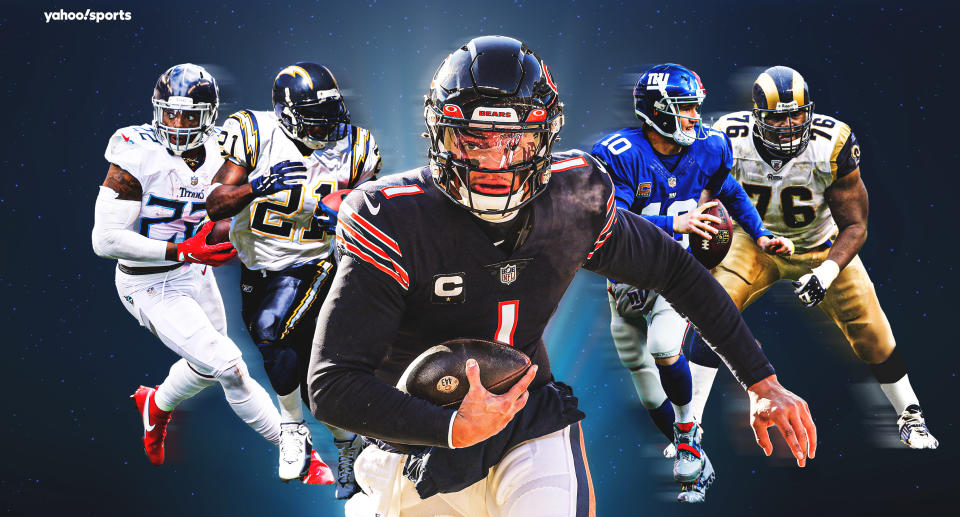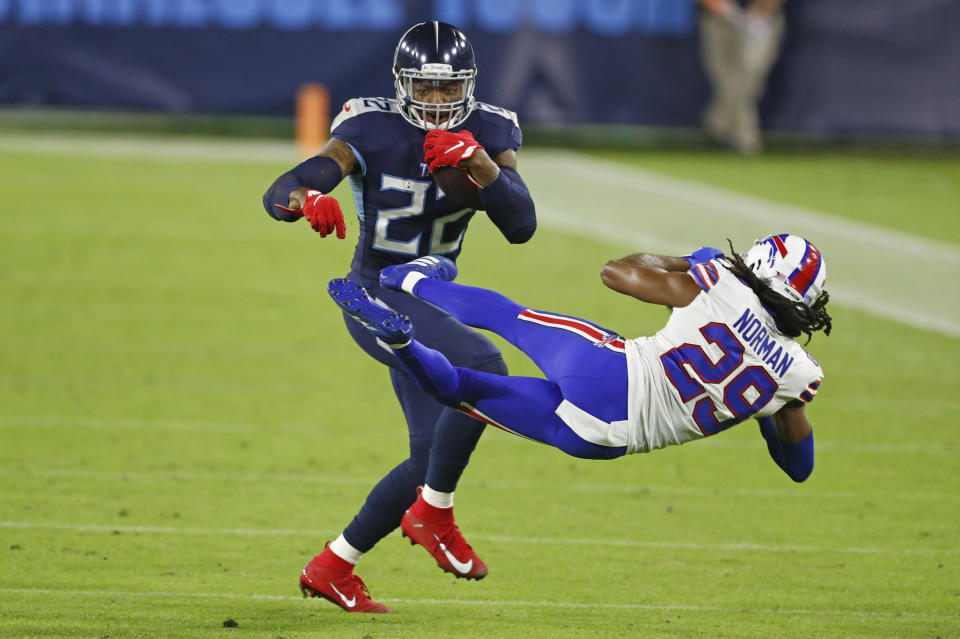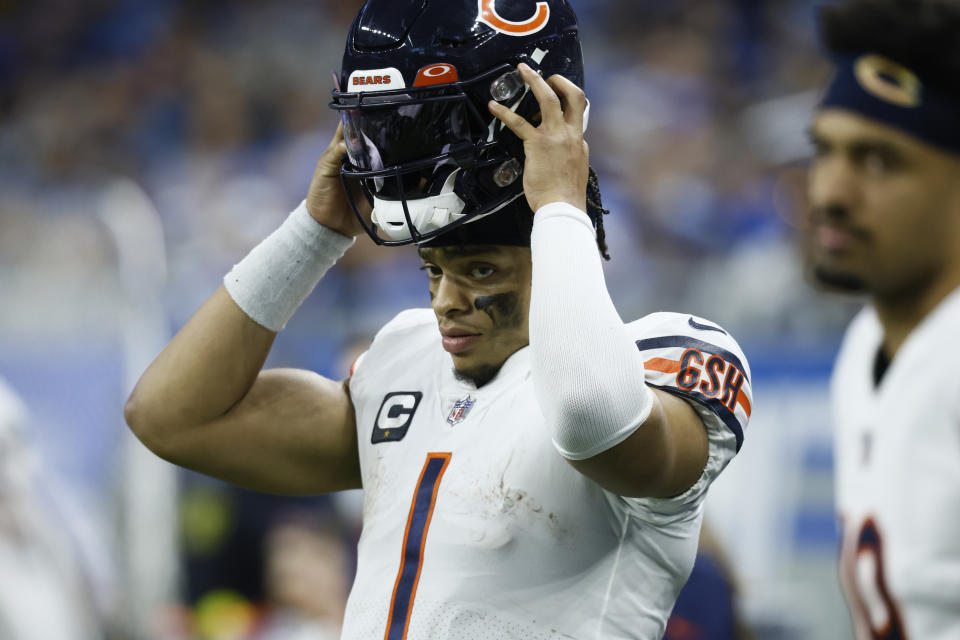The Chicago Bears hold all the power this NFL offseason. The team enters the spring with a potential franchise quarterback in Justin Fields, the most salary-cap space available and the No. 1 overall pick in the 2023 NFL Draft.
With the Bears being the rare team to pick No. 1 that doesn’t appear to be in the market for a quarterback, and with Alabama’s Bryce Young, Ohio State’s C.J. Stroud and Kentucky’s Will Levis considered some of the top players available, it is expected Chicago will look to trade that pick. Given the fervor surrounding that trio and the importance of having an elite quarterback in the NFL, the Bears stand to gain a bevy of picks to — in some cases — draft just a few spots lower in 2023 while acquiring multiple early round picks in 2024 and 2025. Bringing in multiple early round rookies in 2023 could be what the team needs to speed up its rebuild and return to playoff and Super Bowl contention.
How have trades like this worked out for teams in the past? The No. 1 overall pick in the NFL Draft has been traded six times since 1990. Here’s what each of those trades cost. And whether the team trading out of the top spot got enough value to justify the move.


1. Rams give up 6 draft picks to select Jared Goff in 2016
Titans got:
2016 1st-round pick (15th overall)
2016 2nd-round pick (43)
2016 2nd-round pick (45)
2016 3rd-round pick (76)
2017 1st-round pick (5)
2017 3rd-round pick (100)
Rams got:
2016 No. 1 overall pick
2016 fourth-round pick (113)
2016 sixth-round pick (177)
How did the trade work out for the Rams?
The Rams snagged Jared Goff with the No. 1 overall selection in 2016. The move looked worrying after Goff’s rookie season, but he blossomed in new head coach Sean McVay’s offense in 2017. The Rams made the playoffs in three out of the next four years, going all the way to the Super Bowl during the 2018 season. Goff’s tenure in Los Angeles ended on a disappointing note, as he was traded for Matthew Stafford, who won the Super Bowl in his first year with the Rams.
The Rams traded away the fourth-round pick it acquired in the deal and drafted tight end Temarrick Hemingway, who has 1 career catch for 10 yards in four seasons in the NFL, with the sixth-round pick.
How did the trade work out for the Titans?
The Titans stuck with Marcus Mariota under center. Mariota turned in his best season in 2018, throwing 26 touchdowns against 9 interceptions, but regressed after that. The team traded the No. 15 pick in 2016 to move up to No. 8 and select offensive lineman Jack Conklin. He made the All-Pro team as a rookie and has been an above-average right tackle when healthy. Conklin has dealt with injuries over his career, one of which resulted in him leaving the Titans as a free agent after the 2019 season.
The highlight of the rest of Tennessee’s 2016 trade haul is running back Derrick Henry, selected with the 45th overall pick. After a slow start to his career, Henry developed into one of the NFL’s best running backs. He has averaged an incredible 1,510 rushing yards over his past four seasons and made the All-Pro team in 2020.
In 2017, the Titans used the No. 5 pick on wide receiver Corey Davis and the No. 100 pick on tight end Jonnu Smith. Davis had solid years with the Titans, but never exceeded 1,000 yards receiving. Smith had moments with the team too. The Titans let both players walk after 2020.
Who won the deal?
It’s hard to say, both made out well. Goff’s tenure in Los Angeles ended roughly, but he took the team to the playoffs in three of his last four seasons. The Rams had one of the best offenses in the NFL for two straight years with Goff.
The Titans made the wrong choice at quarterback, though Goff’s career might have gone differently without McVay. Tennessee made up for that with value elsewhere. Henry is a star. Conklin has also performed like one when healthy. Davis was never an elite player, but he and Smith were consistent starters in Tennessee for four seasons before leaving.


2. Chargers trade Eli Manning for Philip Rivers during 2004 NFL Draft
Chargers got:
Philip Rivers (No. 4 overall pick)
2004 3rd-round pick (65th overall)
2005 1st-round pick (12)
2005 6th-round pick (144)
Giants got:
Eli Manning (No. 1 overall pick)
How did the trade work out for the Giants?
Manning spent his entire 16-year career with the Giants, winning two Super Bowls and starting 234 games with the franchise. He was never an All-Pro, but was named to the Pro Bowl four times. Manning struggled with turnovers at times in his career, throwing at least 20 interceptions in three seasons. He also proved to be extremely clutch when it mattered on the biggest stage.
How did the trade work out for the Chargers?
Rivers put up better passing numbers than Manning over their careers. Rivers made eight Pro Bowls and finished in the top six of MVP voting twice. Despite that, Rivers never made it to a Super Bowl.
The Chargers used the No. 65 pick on kicker Nate Kaeding, who made one All-Pro team during a solid career, but the real score was pass rusher Shawne Merriman with the No. 12 overall pick in 2005. Merriman performed like a star early in his career, being named defensive Rookie of the Year and making three straight All-Pro teams before injuries limited his ability. The Chargers dealt the No. 144 pick from the trade.
Who won the deal?
Again, both teams look good, but the Giants got two Super Bowl rings out of the deal so we’ll go with them. The Chargers wound up with a franchise quarterback of their own, not to mention a solid kicker and an elite pass rusher with a short peak. Both teams were frequent contenders and made multiple postseason appearances thanks to this trade.
3. Falcons trade up to land Michael Vick in 2001
Falcons got:
Michael Vick (No. 1 overall pick)
Chargers got:
2001 1st-round pick (5th overall)
2001 3rd-round pick (67)
2002 2nd-round pick (48)
WR Tim Dwight
How did the trade work out for the Falcons?
Vick never put up elite passing numbers, but changed how the quarterback position was viewed forever. He helped pave the way for other hybrid passers and rushers who would eventually become mainstays at the top of the NFL Draft. Vick never made an All-Pro team, but finished in the top-four of the MVP voting twice. His Falcons career was cut short after six seasons when he was arrested and later pleaded guilty for operating a dog-fighting ring. He spent 21 months in prison before returning to the NFL in 2009 with the Philadelphia Eagles, and he won Comeback Player of the Year and went to the Pro Bowl in 2010.
How did the trade work out for the Chargers?
The Chargers turned the No. 5 pick in 2001 into Pro Football Hall of Famer LaDainian Tomlinson, one of the best running backs in NFL history. The other two picks were cornerback Tay Cody and the late Reche Caldwell. Meanwhile, Dwight caught 50 balls for 623 yards in 2002 and then caught 16 passes with the team over the next two seasons combined.
Who won the deal?
The Chargers drafted a Hall of Famer, so it’s hard to argue against them here. The rest of their picks didn’t do much in the NFL. Vick was a unique and explosive player for his era and had a major influence on the future of the position. He was a really good player for the Falcons before his dog-fighting arrest.
4. Rams trade up for Orlando Pace in 1997
Jets got:
1997 1st-round pick (6th overall)
1997 3rd-round pick (67)
1997 4th-round pick (107)
1997 7th-round pick (207)
Rams got:
1997 No. 1 overall pick
How did the trade work out for the Rams?
Pace was worth the king’s ransom. He made seven Pro Bowls and three All-Pro teams during his 13-year career in the NFL. He was regarded as one of the best left tackles in the game during his prime, and was a key part of the Rams’ “The Greatest Show on Turf” offense. Pace helped lead the team to a Super Bowl title in the 1999 season and was inducted into the Pro Football Hall of Fame in 2016.
How did the trade work out for the Jets?
The Jets were desperate for more draft picks after giving up four selections, including a third-rounder and fourth-rounder in 1997, to acquire head coach Bill Parcells from the New England Patriots. The trade from the No. 1 spot helped the Jets get those picks back, though Parcells continued to wheel and deal.
He eventually traded the No. 6 pick to the Seattle Seahawks for the No. 8 pick. In doing so, Parcells lost out on two Hall of Fame offensive linemen. Pace went to the Rams at No. 1 and the Seahawks took Walter Jones at No. 6. Parcells took James Farrior at No. 8. Farrior had a strong career, but didn’t blossom until going to the Pittsburgh Steelers in 2002. Parcells used the fourth-round pick in defensive end Terry Day, who played one year in the NFL.
Who won the deal?
The Rams got a Hall of Famer. The Jets got a decent linebacker who was better with another team and a defensive lineman who played one year in the NFL. The Rams undoubtedly won the trade.


5. Expansion Panthers trade out of No. 1 spot in 1995
Panthers got:
1995 1st-round pick (5th overall)
1995 2nd-round pick (36)
Bengals got:
1995 No. 1 overall pick
How did the trade work out for the Bengals?
The Bengals took Penn State running back Ki-Jana Carter with the No. 1 overall pick. After a productive college career, Carter tore his ACL in his third carry in the preseason. He missed all of 1995 rehabbing from the injury. He returned in 1996, but failed to live up to his draft status. He sustained various other injuries in his career, keeping him from reaching his potentially elite ceiling.
How did the trade work out for the Panthers?
The Panthers knew they needed a quarterback as their franchise was getting off the ground. The team took Penn State’s Kerry Collins with the No. 5 pick. Collins’ most productive seasons came later in his career, though he made a Pro Bowl with the Panthers in 1996. The team took defensive end Shawn King in the second round, who played four seasons in the NFL, but started just two games with the Panthers.
Who won the deal?
The Bengals definitely lost, but it’s tough to say the Panthers won big. By today’s standards, Carolina didn’t get much back for the No. 1 pick and missed on both their selections. Collins went on to have a fine career, but his best seasons, including his Super Bowl trip with the Giants in the 2000 season, came after leaving Carolina.
6. Colts trade up to take Jeff George in 1990
Falcons got:
OT Chris Hinton
WR Andre Rison
1990 5th-round pick (121st overall)
1991 1st-round pick (13)
Colts got:
1990 No. 1 overall pick
1990 fourth-round pick (83)
How did the trade work out for the Colts?
The Colts spent the No. 1 pick on Illinois quarterback Jeff George, who had talent but was a disaster in Indianapolis. George lasted four seasons with the Colts, tossing 41 touchdowns against 46 interceptions. The team took wideout Stacey Simmons in the fourth round. He played one year in the NFL.
How did the trade work out for the Falcons?
Hinton continued to play at a high level after being traded. He made the Pro Bowl in 1991 and was elected to his only All-Pro team in 1993 with the Falcons. Rison was named All-Pro in four straight seasons with the club. Atlanta took offensive lineman Reggie Redding and receiver Mike Pritchard with the other two picks from the trade.
Who won the deal?
The Falcons got two excellent players in the deal. The Colts traded George after four seasons. The Falcons may not have hit big with either of their draft picks, but they still won this one.


Should the Bears trade away the No. 1 overall pick?
The rising cost of trading for the No. 1 overall draft pick suggests the Bears won’t be too upset if they make a deal. The Panthers and Colts gave up just one first-round pick to move up to the No. 1 overall slot in the ’90s. The Rams gave up two first-round picks and two second-round picks for Goff.
That gives the Bears multiple chances to hit on impact players in the early rounds of the next couple drafts. It’s not like 1995, when the Panthers had just two chances to get solid players after dealing the No. 1 overall pick. If the Goff trade is any indication, the Bears should get at least four or five additional picks if they trade out of the No. 1 slot.
The Bears have to make the most of those selections in order for the trade to pay off. That’s no guarantee given the uncertainty of the draft, but the margin for error would be much larger with multiple early round picks.
